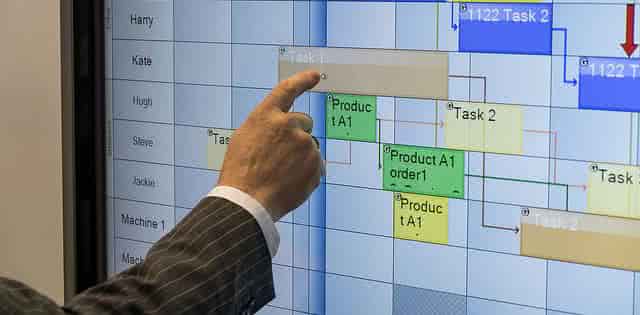Project Management
6 Tips for Choosing the Best Project Management Software

In addition to maintaining the most qualified manpower to carry out vital tasks and attain organizational goals, more and more companies are using project management tools to simplify the way their projects are planned, managed and executed. These types of tools are becoming even more prevalent for companies with teams scattered across the globe and individual members who are constantly on the go.
Yet choosing the best project management software — or any software, for that matter — can be tricky, particularly if you have no idea where to start or what you’re looking for. And, since there’s no such thing as a one-size-fits-all solution despite the many breakthroughs in software development, there are several tips to remember when choosing the best project management software. Below, we explore are six of those tips.
1. Know What Your Business Needs
![]() To help point you in the right direction, we’ve compiled a list of some of the most sought-after project management software features, such as online collaboration, task management and distribution, role-based access controls and real-time reports. It’s also important that the platform provide seamless communication through threaded comments and conversations that are automatically attached to project workspaces.
To help point you in the right direction, we’ve compiled a list of some of the most sought-after project management software features, such as online collaboration, task management and distribution, role-based access controls and real-time reports. It’s also important that the platform provide seamless communication through threaded comments and conversations that are automatically attached to project workspaces.
Here’s a checklist of some other key functions to consider:
- Software security and data integrity
- Gantt-chart view of schedules and dependencies
- Integration with MS Project and other third-party software
- Resource management
- Risk and issue management
- Portfolio management
- Document management and storage
- Project expense tracking
- Budgeting and time tracking
- Member timesheets
- Easy-to-use UI
- Vendor support
- Native iOS and Android apps
This isn’t to say, however, that the solution with all of the above capabilities is the best of the project management software bunch. If you’re a startup with simple project collaboration and communication needs, a full-fledged project management software complete with Gantt charts, time-tracking, invoicing and organizational chart features may be a bit much.
In other words, you need not get what you don’t need, as anything more than essential is putting unnecessary strain on the company’s financial reserves, in addition to steepening the learning curve.
2. Determine Existing Business Capabilities
![]() Solicit input from departments and team members who will be directly impacted by the software roll-out. These people are in the line of fire, so to speak, so they’re best suited to identify what makes their tasks and projects easier to accomplish.
Solicit input from departments and team members who will be directly impacted by the software roll-out. These people are in the line of fire, so to speak, so they’re best suited to identify what makes their tasks and projects easier to accomplish.
If your team members already use an existing task management app like Evernote for their personal needs, consider investing in a business edition of the software. Subscribing to Evernote Business, for example, lets you centrally manage your team members’ Evernote accounts and boosts team productivity in the process.
Additionally, if your company is a heavy MS Project or Outlook user, adopting a solution that readily works with said systems, like Comindware Project, eliminates the need to manually recreate your project plans or re-enter business-critical data. In the absence of these functions, choose one that has API (application programming interface) capabilities, so the information flow between applications becomes seamless.
3. Take Advantage of Free Trials
![]() Because investing in software is not exactly cheap — especially if the basic or free options don’t satisfactorily address your company’s needs — knowing what you’re getting before paying for it is a prudent move. Free full-featured trial periods usually last for 15 days, with some extending up to a month; that should be enough time to understand what the software can offer and whether or not it meets your business criteria.
Because investing in software is not exactly cheap — especially if the basic or free options don’t satisfactorily address your company’s needs — knowing what you’re getting before paying for it is a prudent move. Free full-featured trial periods usually last for 15 days, with some extending up to a month; that should be enough time to understand what the software can offer and whether or not it meets your business criteria.
4. Compare Various Project Management Solutions
![]() Software comparison starts with identifying your unique needs and then narrowing down the list based on what options answer those needs. To compare the capabilities of various project management solutions, try them out and check out product reviews to help identify each of their unique selling points.
Software comparison starts with identifying your unique needs and then narrowing down the list based on what options answer those needs. To compare the capabilities of various project management solutions, try them out and check out product reviews to help identify each of their unique selling points.
Aside from reasonable pricing and just the right amount of user/collaborator slots, vendor availability and community support are important considerations, especially at the onset when timely answers to queries are critical for successful implementation.
5. Cloud-Based vs. On-Premise
![]() For businesses with geographically dispersed teams, a cloud-based project management software is the ideal option. Because the solution is web-based, it can be accessed anywhere, anytime and on any device — a distinct advantage for the mobile workforce that is expected to remain productive even while out of the office.
For businesses with geographically dispersed teams, a cloud-based project management software is the ideal option. Because the solution is web-based, it can be accessed anywhere, anytime and on any device — a distinct advantage for the mobile workforce that is expected to remain productive even while out of the office.
For companies who would rather keep their data in-house and understand the costs pertaining to ownership and upkeep, an on-premise solution is likely the better alternative.
6. Choose the Software that Can Grow with You
![]() Businesses are meant to grow, so change is a constant. The project management software you choose must keep up as your company scales. A good option is one that offers various plans based on the number of users, storage requirements and feature add-ons, among other components.
Businesses are meant to grow, so change is a constant. The project management software you choose must keep up as your company scales. A good option is one that offers various plans based on the number of users, storage requirements and feature add-ons, among other components.
Want more handy tips from leading experts on software selection? The Business-Software.com blog offers tons of great content that covers everything from implementation and industry trends to product comparisons and more.
[Photo courtesy of flickr user CeBIT Australia.]






